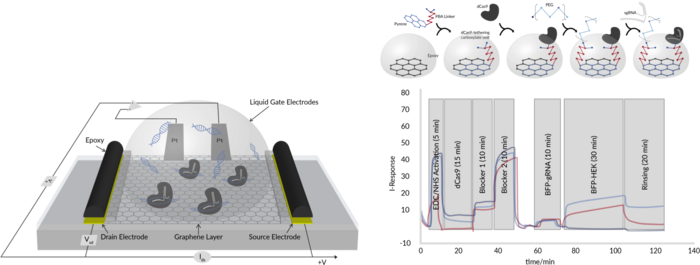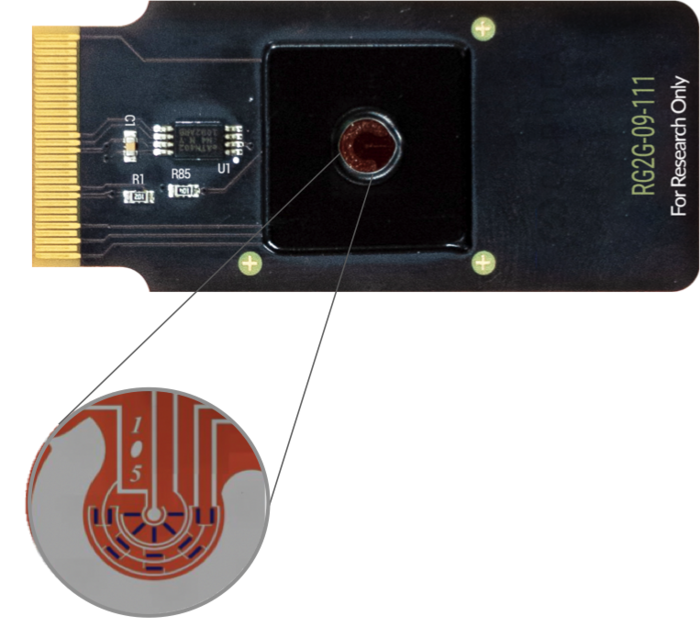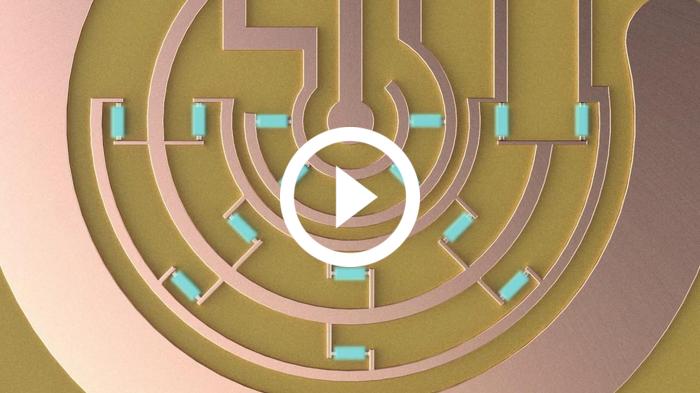The CRISPR-Chip can optimise your Cas, diagnose COVID19 and change our world, interview Kiana Aran, CSO Cardea Bio

It's no wonder the CRISPR-Chip made the cover of Nature Biomedical Engineering and became the most read publication in 2019. The chip integrates three of the greatest inventions in our times - the transistor, graphene, and CRISPR - into a super-sensitive graphene-based CRISPR-powered transistor for fast detection of heritable disease variants as well as infectious diseases like COVID19.
The potential for applications is vast, and now the first CRISPR-chip product is near launch. It is a quality control (QC) set-up using robots for quickly validating CRISPR-Cas complexes - a process that usually takes several time-consuming steps.
»With our chip, you can do that significantly faster - in a matter of minutes. It provides a tool for replacing those lengthy electrophoresis gels if biologists are willing to switch from gels to electronics. Which is the most difficult part,« says Kiana Aran, who invented the CRISPR-Chip. The Iranian-born electrical and bioengineer is co-founder of Cardea Bio and assistant professor at the Keck Graduate Institute (KGI), a member of the Claremont Colleges.
Another product is to optimise different designs of Cas endonuclease variants using the CRISPR-chip to monitor binding efficiency while engineering Cas and guide RNAs.
The CRISPR-Chip is extremely sensitive so that designs can be tested directly on whole-genome samples rather than the amplified DNA.
»We really don't want to amplify the target,« says Aran.
»Because with an amplicon, you still don't know how well they work in the whole genome - you have to do an in vitro experiment and then move to an in vivo experiment.«
The transistor, graphene and CRISPR
You have probably heard about the CRISPR-Chip by now, but if not, briefly here is what it is.
Aran's invention is simple in principle: Two electrodes connected by a graphene sheet. Current enters on one side and exits on the other, and you can measure changes in the conductivity. There is a third electrode that controls the gate electric field.
VIDEO: The CRISPR-Chip design and principle. Courtesy Kiana Aran/Cardea Bio
At the core sits graphene - the wonder material of the 2010 Nobel prize that is a hundred times stronger than steel and more conductive than copper. These properties are due to the single-atom-thick sheet of carbon atoms arranged in a hexagonal lattice permeated by a sea of delocalised electrons.
Also, graphene is biocompatible and works in aqueous solutions without being corroded (unlike silicon-based electronics), and this is, of course, crucial for merging with biological samples.
To functionalise the CRISPR-Chip, Aran and colleagues attach thousands of Cas endonucleases to the graphene sheet via linker molecules. Then, they block any unbound sites on the graphene, and finally, program the Cas with a guide RNA.
The graphene is extremely sensitive to charged molecules - and all biological molecules like our DNA are charged - so when the CRISPR-Cas complex binds its DNA target, it will bring charges down to the graphene surface. This changes the conductivity from the base level to a signal specific to the molecule.
Quality control and kinetics
The functionalised CRISPR-Chip is the basis for using the CRISPR 'DNA-search-engine' as a diagnostic tool, which Aran and colleagues have shown can detect the causative mutations of Duchenne Muscular Dystrophy and sickle cell disease.
However, the basis for the QC product is the prior functionalisation process itself.
»We can monitor all the functionalisation steps in real-time. So this is where we can do CRISPR quality control for people who are modifying the Cas enzyme or the guide RNA. How much modifying your guide RNA affects the affinity of the guide to the Cas? Or how much changing your Cas affects the affinity of the two together?,« says Kiana Aran.

By designing, say, 20 different Cas variants and functionalising 20 separate transistors on the CRISPR-chip, the best variant can be found quickly.
Cardea Bio has robotic set-ups that can run up to 24 CRISPR-chips at the same time and process the measurements in 15-30 minutes.
With scientists these days identifying different types of CRISPR-Cas weekly and engineering new variants, Kiana Aran says the CRISPR-Chip can help put the puzzle pieces together, and map out which are suitable for what applications.
The system can operate in a high-speed measurement mode, meaning it takes measurements extremely fast and generates megabytes of data. From that type of data, it is possible to analyse the kinetics of binding and unbinding. That is of interest to pharma companies.
»Also, we can help with understanding off-target effects and what influences those off-target activities. I think having tools like this can enable us to understand better how to best use CRISPR for therapeutics.« says Aran.

COVID19 surveillance and tracking
These first CRISPR-Chip based products are just the beginning, and diagnostics of genetic diseases and pathogens like SARS-COV-2 are obvious next steps.
»Our chip can utilise the advances and discoveries in CRISPR technology to develop new diagnostic tools and one day eliminate amplification all-together‚« says Kiana Aran.
She is now collaborating with other scientists including professor Virginijus Siksnys, Vilnius University, Lithuania, a world-renowned biochemist and pioneer in CRISPR, to develop another type of CRISPR-chip.
CRISPR is already applied as diagnostic tools to help fight the COVID19 pandemic for example by Sherlock Biosciences, but the CRISPR-Chip set-up would be far superior since it is digital data that can be uploaded to the cloud and analysed immediately and the results can be seamlessly used for trace tracking.
»You know, it is not acceptable that the United States - the most modern society - still reports the COVID patient results on paper or pdf files to the agencies‚« says Kiana Aran.
»Whatever testing system we develop as we continue to fight this pandemic and prepare for the future ones, it has to be electronic, and the data has to be transferred without the user or doctors interfering, otherwise tracking will not be possible. «
The graphene-transistor would allow for fast and digital biosurveillance, which could help spot new outbreaks and efficient response.
Wearables and healthy ageing
In the future, a CRISPR-Chip sensor could even be built into wearables like smartwatches since graphene is a flexible material, and it is sensitive enough to measure molecules on our skin.
»What I envision - even beside COVID - is that we have identified a lot of biomarkers for various pathologies, but we have not used that knowledge to monitor our health. For example, we have identified many biomarkers that are associated with how well we are ageing. Still, we are not using them to monitor and take control over our health« says Kiana Aran.
»Imagine that you can get access to that information and the levels of those biomarkers starting when you are in your 20's or 30's that tell you the level of these biomarkers at the healthiest stages of your life. Then you have the option to maintain the level of these biomarkers as you age. CRISPR-chip and other types of graphene transistors and nanoelectronics that we are developing can give you access to this information at the palm of your hand.«
A lot more advanced than monitoring your weight, but the same principle - through lifestyle choices like diet, food, exercise etc. you want to stay at the same level.
»I could see the future where we monitor everything digitally, or a future when there is a pandemic, there are chips available that you can just order on Amazon. Get a Flu chip, a COVID Chip - and you can test daily,« says Kiana Aran.
It sounds very futuristic.
»Yeah, but remember the cellphone 20 years ago? It was huge, and it could primarily make calls with not so good quality. Now we use them for things like listening to music, browsing the web, playing games, and watching videos. If you told someone 20 years ago what these devices would be capable of, it would have sounded like science fiction. I hope that I can see the day that we can use modern electronics to monitor everything and connect with our biology directly during the next 10-15 years.«
A new paradigm
And futuristic as it sounds, that is not even the most revolutionising dream.
The graphene transistor follows Moore's law, and the goal is a CRISPR-Chip that holds millions of transistors each able to monitor specific biological interactions.
»This is the beauty of it. Because you can make transistors super small, you can multiplex them, and you can have millions of them in a single small chip. Like in our cellphone. This will enable a future where you can get access to your biology and health, the same way you get access to other types of information using your cell phone,« says Kiana Aran.
She believes the chip will eventually be able to capture thousands of molecular signals simultaneously and thereby help researchers understand the complex dynamics of biological systems.
»Each of the biomarkers in our body is changing continuously, and they impact each other. The way they impact each other is controlled by tissue type, cell membranes and other conditions. In other words, an extensive series of differential equations with multiple parameters changing together and with boundary conditions. The future sensors can gather all the information - the levels of all these biomarkers over time - and we can solve the differential equations with our existing technologies today and get closer and closer to understanding the mystery of our human body,« says Kiana Aran.
By bridging biology and electronics, the graphene transistor could soon open a door into the biomolecular world, that not only has the potential to change how we understand biology, but also to change our world.
Kiana Aran and Cardea
Kiana Aran was born in Iran during the Iran-Iraq war, and what she remembers of her childhood is »it was dark memories during the war«. She came to the United States in 2002, pursued a degree in electrical engineering »because in Iran if you were good in math and science and interested in engineering, you would study electrical engineering« even though she did not like it. »It was super boring for me just designing transistors and diodes and antennas,« she says.
The only motivation was she wanted to be the best in whatever she was doing. She did her PhD in biomedical engineering and then a post-doc at UC Berkeley, where she discovered her passion for utilising an entrepreneurial spirit, and »electronics just turned to be so much fun.«
Kiana Aran invented an ingestible drug delivery device and started her first company, but after »failing « she never thought she would start another. That changed after she invented the CRISPR-Chip and her collaborative work with Ross Bundy and Brett Goldsmith, the two founders of another company Cardea Bio that were producing commercial graphene-based transistors. »I was familiar with the difficulty with making graphene transistors as I was doing it myself. Brett and Ross spent years to not only make these transistors with high quality but also scale up their production. So I met them at the right time and truly enjoyed collaborating with them,« says Kiana Aran.
Kiana was then introduced to Michael Heltzen, a serial entrepreneur and a visionary in life science and the genomic space, and they co-founded Nanosens Innovations. The collaboration between the two companies became so strong that after a year, the two companies merged to become Cardea Bio, where Kiana is now a cofounder and Chief Science Officer.
Tags
ArticleInsightInterviewDiagnosticsQuality ControlCRISPR-CasCardea Bio
CLINICAL TRIALS
Sponsors:
Suzhou Maximum Bio-tech Co., Ltd.
Sponsors:
Zhejiang University








